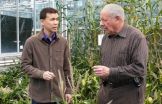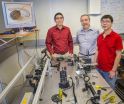(Press-News.org) WEST LAFAYETTE, Ind. - Lowering temperatures for two hours each day reduces the height of corn without affecting its seed yield, a Purdue study shows, a technique that could be used to grow crops in controlled-environment facilities in caves and former mines.
Raising the crops in isolated and enclosed environments would help prevent genetically modified pollen and seed from escaping into the ecosystem and crossing with wild plants.
Cary Mitchell, professor of horticulture, said the technique could be particularly useful for growing transgenic crops to produce high-value medicinal products such as antibodies for the budding plant-derived industrial and pharmaceutical compounds industry.
"Grains of corn could be engineered to produce proteins that could be extracted and processed into medicine, pharmaceuticals and nutraceuticals such as essential vitamins," he said. "This is a young industry, but what we've done is show that you can successfully grow these high-value crops in contained environments."
Mitchell described corn as a "good candidate crop" for the industry because of the plant's bounty of seeds and well-characterized genome, which can be modified in many ways. Using plants as "factories" to generate bioactive medicines would be far cheaper than the current methods that rely on cell cultures from mammals, he said.
But raising corn - a towering crop that needs bright light and heat - in a dark, cool, underground mine presented a challenge to Mitchell and then-postdoctoral researchers Yang Yang and Gioia Massa. They installed a growth chamber with insulation and yellow and blue high-intensity discharge lamps in a former limestone mine in Marengo, Indiana, to test how corn would react to an environment in which its growing conditions - light, temperature, humidity and carbon dioxide - were tightly controlled. To their surprise, the hybrid corn responded by growing "too well," said Yang.
"We coddled the plants with such luxurious conditions that the corn was touching the lamps before it had even tasseled," he said.
To reduce the corn's height, the researchers borrowed a trick used by the greenhouse industry to dwarf Christmas poinsettias. Using a growth chamber that mimicked the temperature conditions and carbon dioxide levels of the Marengo mine, they dropped the temperature to 60 degrees Fahrenheit for the first two hours of each photoperiod, the time in which the corn received light. The temperature was restored to 80 degrees for 14 hours and then lowered to 65 degrees for eight hours of darkness.
The temperature dip dwarfed stalk height by 9 to 10 percent and reduced stalk diameter by 8 to 9 percent without significantly affecting the number and weight of the seeds.
"This is a technique you could easily do in a mine or cave," Mitchell said. "It is an affordable, non-chemical means of taking genetically modified crops to harvest maturity without getting any kind of pollen or seed into the ecosystem."
He said that former mines could be prime locations to grow high-value, transgenic plants because their natural coolness lessens the need to ventilate the heat produced by lamps. The high levels of carbon dioxide in mines also promote plant growth.
"Productivity in a controlled environment is superior to that in the field, and you can raise more than one crop per year," Mitchell said. "Controlled environment agriculture is going to be one of the big movements of the 21st century."
INFORMATION:
The study was published in Industrial Crops and Products and is available at http://www.sciencedirect.com/science/article/pii/S0926669013006791
Funding for the research was provided by a grant from the Indiana 21st Century Research and Technology Fund to Doug Ausenbaugh, president of Controlled Pharming Ventures.
Corn dwarfed by temperature dip suitable for growing in mines, caves
2014-05-12
ELSE PRESS RELEASES FROM THIS DATE:
INFORMS study: Online buzz forecasts new product performance months before product release
2014-05-12
Companies can significantly improve the forecasting accuracy of forthcoming products' performance by mining online consumer buzz prior to product release, according to a study being published by Marketing Science, a journal of the Institute for Operations Research and the Management Sciences (INFORMS).
Social media attention to a firm's forthcoming products also influences its stock price, the study shows.
Pre-Release Buzz Evolution Patterns and New Product Performance is by Guiyang Xiong and Sundar Bharadwaj, professors at Terry College of Business at the University ...
Potential cure for captive amphibians with chytrid fungus
2014-05-12
Researchers at Vanderbilt University have identified an alternative to a sometimes toxic therapy that protects frogs in zoos from a deadly fungal infection that has been destroying the amphibian populations worldwide. Their research is published ahead of print in Applied and Environmental Microbiology.
The fungal disease, chytridiomycosis, has been decimating frogs all over the world. At present, nothing can help amphibians in the wild, but zoos currently rely on the often-toxic itraconazole to eradicate the disease from infected amphibians they wish to acquire.
To ...
UBC scientists find new way to mobilize immune system against viruses
2014-05-12
University of British Columbia scientists have uncovered an intricate chain reaction in the body's immune system and have used the knowledge to develop a new treatment against harmful viruses.
Viral pandemics, such as the coronavirus that caused the deadly SARS outbreak in 2002, have caused hundreds of deaths in Canada, yet effective anti-viral drugs are rare.
A key element to this natural immune response is an antiviral protein in the blood called Interferon alpha. Like soldiers, Interferon alpha is quickly deployed by the body to fight viruses and removed just as ...
Alcohol and drugs: Not just for modern man
2014-05-12
Unlike modern Man, the prehistoric people of Europe did not use mind-altering substances simply for their hedonistic pleasure. The use of alcohol and plant drugs – such as opium poppies and hallucinogenic mushrooms – was highly regulated and went hand-in-hand with the belief system and sacred burial rituals of many preindustrial societies. Elisa Guerra-Doce of the Universidad de Valladolid in Spain contends that their use was an integral part of prehistoric beliefs, and that these substances were believed to aid in communication with the spiritual world. Guerra-Doce's research ...
All in the rotation
2014-05-12
Viruses are the enigma of the biological world – despite having their own DNA and being able to adapt to their environment and evolve, they are not considered to be alive like cells. In order to reproduce and multiply – a requirement of "life" - a virus must invade a living cell, eject its DNA into that of the cell, and commandeer the cell's biological machinery. While a virus, essentially, may be nothing more than a dollop of DNA packed into a protective coating of protein called a capsid, the packaging of that DNA is critical. The molecular motors that drive this DNA ...
Video stories, other bonding exercises could help foster families connect
2014-05-12
Teenagers and their foster families often say they don't feel connected and have trouble communicating, but few resources exist that nurture their bonding. In a research paper being published in the June issue of Children and Youth Services Review, researchers affiliated with the University of Washington's School of Social Work describe how they tailored a parenting program known to improve communication in non-foster families for use in foster families.
"Every family has its own unique dynamics, such as different rules or expectations. When teens are placed into a foster ...
Two genes together drive aggressive prostate cancer
2014-05-12
NEW YORK, NY (May 12, 2014) —Two genes work together to drive the most lethal forms of prostate cancer, according to new research from the Herbert Irving Comprehensive Cancer Center at Columbia University Medical Center (CUMC). These findings could lead to a diagnostic test for identifying those tumors likely to become aggressive and to the development of novel combination therapy for the disease.
The two genes—FOXM1 and CENPF—had been previously implicated in cancer, but none of the prior studies suggested that they might work synergistically to cause the most aggressive ...
Second opinion changes diagnosis from incurable to curable cancer
2014-05-12
AURORA, Colo. (May 5, 2014) - The Journal of Clinical Oncology reports the case of a woman diagnosed with advanced, incurable lung cancer, whose disease was in fact early stage, curable lung cancer with additional lung lesions due to a rare antibiotic side effect. When her primary lung tumor was surgically removed, and the antibiotic stopped, the 62-year-old woman recovered and may now be cured.
"In a good example of collaboration with our local oncology community, my colleague wanted a second opinion to ensure his patient got the best possible treatment plan established ...
In the age of open science, repurposing and reproducing research pose their own challenges
2014-05-12
DURHAM, N.C. – Growing numbers of researchers are making the data and software underlying their publications freely available online, largely in response to data sharing policies at journals and funding agencies. But in the age of open science, improving access is one thing, repurposing and reproducing research is another. In a study in the Journal of Ecology, a team of researchers experienced this firsthand when they tried to answer a seemingly simple question: what percentage of plants in the world are woody?
They thought the answer would be easy to find. After all, ...
Climate negotiation as a bargaining game
2014-05-12
For more than two decades, members of the United Nations have sought to forge an agreement to reduce global greenhouse gas emissions. But so far, these international climate negotiations have had limited success.
What's more, game theoretical modeling of the negotiations suggests that there are feasible solutions to the problem. That is, there are commitments that the countries participating in the negotiations could agree to that would accomplish the targeted global emissions reductions. "So, if these solutions are there, the question is why negotiations have not yet ...

